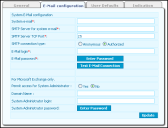System Email Configuration
System-wide UM email settings are configured on the E-Mail configuration tab on the Unified Messaging page.
To Configure the UM Settings on the E-Mail Configuration Tab:
1.In the Management Portal, click System Configuration > Users > Unified Messaging.
2.On the E-Mail configuration tab:
•System e-mail (Required) - The default email address of the system. The Answering application uses this as the sender address when there is anonymous access to the outbound email server, or when there is authorized access but the user did not provide a valid PIN (or an input time-out occurred).
•SMTP Server for system e-mail (Required) - The host name or IP address of the SMTP server responsible for outgoing mail.
•SMTP Server TCP Port (Required) - The TCP port of the SMTP server for outgoing system email. The default is 25.
•SMTP connection type - The type of access the email server allows:
•Select Anonymous to let users send voice mail without entering a PIN.
•Select Authorized to require users to enter a PIN to send voice mail; selecting this option displays the E-Mail login and E-Mail password fields.
•E-Mail login (Required) - If you select the Authorized option in the SMTP connection type field, enter the login to the default system email.
•E-Mail password (Required) - If you select the Authorized option in the SMTP connection type field, click the Enter Password button to enter the password for the system email.
•Test E-Mail Connection - Click this button to test the connection between Ivanti Voice and the default system email account. If you selected the Authorized option in the SMTP Connection Type field and entered the Email Login and Email Password, click the Update button to commit changes before clicking the Test E-Mail Connection button to test the connection.
3.Click the Update and Commit Changes buttons to enact your edits, or proceed to "Microsoft Exchange Configuration Settings" below to continue configuring settings on this page. If you do not need to configure the Microsoft Exchange settings, proceed to User Defaults Configuration to continue configuring the system-wide Unified Messaging.
Microsoft Exchange Configuration Settings
Corporate email systems typically allow only authorized access, and prompt users to change passwords periodically. When the user account passwords set in the Management Portal expire, the Access application cannot use the accounts to access mailboxes to read new mail. If you use the Access application with a Microsoft Exchange Server as the default server, you can create a Microsoft Exchange Server account that allows access to user mailboxes without a password.
Refer to Microsoft Windows Active Directory information for details regarding how to configure an account to allow access to user mailboxes without a password (or contact your account representative for a copy of the document entitled “System Administrator Access to Unified Messaging for Exchange Mail Systems”).
To Configure the Microsoft Exchange Settings:
1.Complete the fields below in the For Microsoft Exchange only section (found on the E-Mail configuration tab on the Unified Messaging page) only if you are using Microsoft Exchange Server as the system email server:
•Permit access for System Administrator - Indicate if you want to let the UM functionality use a system administrator account to access all UM user accounts regardless of whether the current passwords match the passwords defined in the Management Portal. If you select No, the Domain Name, System Administrator login, and System Administrator password fields are removed.
If you select No, you must manually reset passwords in the Management Portal whenever the email system prompts change.
•Domain Name - If you selected Yes in the Permit access for System Administrator field, enter the Windows domain name for the system administrator account (Microsoft Exchange Server).
•System Administrator login - If you selected Yes in the Permit access for System Administrator field, enter the Microsoft Exchange Server system administrator login.
•System Administrator password - If you selected Yes in the Permit access for System Administrator field, click the Enter Password button and enter the Microsoft Exchange Server system administrator password.
2.Click the Update and Commit Changes buttons to enact your edits. Proceed to User Defaults Configuration to continue configuring the system-wide Unified Messaging.
